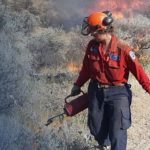Home »

Bear conflict resolution opportunities presented to city
By Erin Knutson
The City of Fernie was presented with an overview of potential opportunities for local government to ease human-wildlife conflict, bears explicitly, at their recent committee of the whole meeting (May 16).
Wildlife scientist Clayton Lamb from the University of British Columbia discussed the density of conflicts with grizzly bears across B.C. and the importance of mitigating these disturbances.
“We support quite a few grizzly bears in the valley, so we have several conflicts due to bears and people sharing space, including some attractant issues,” said Lamb.
According to Lamb, the entirety of the East Kootenay is bear rich and home to the spectacular apex predators.
“This issue is not restricted to Fernie, which is something that all of the communities here, especially in the Elk Valley, are challenged with – we see clusters of bears in Sparwood, around Elkford, Hosmer, Jaffray and Fernie.”
Lamb monitors bears through tracking collars and can chart bear traffic and clusters. At any given time, there are a dozen to 20 collared bears.
“We’ve collared 64 grizzly bears between Jaffray and Elkford, and those collars stay on for one to four years. There are never more than 64 animals collared at one time – collars fall off, and animals die quite frequently, so usually, it’s a dozen to 20 active bears at one time,” said the wildlife scientist.
The collars allow scientists to locate the bears every two hours using a GPS signal.
Data generated from the collars is essential to helping reduce conflict in these concentrated areas.
“My focus is on large mammals across western North America and the Kootenays as it’s my home and the place I care deeply about – my work focuses on producing science that supports meaningful outcomes for wildlife, landscapes, and people,” he said.
Fernie lies in a wildlife corridor, and bears will naturally be attracted to the perimeter where they can grab apples and retreat into the forest. This is a gateway for them, said Lamb.
By tightening up bylaws for attractants such as backyard chickens and the compliance with electric fencing, the removal of fruit trees from properties, and the proper storage of waste bins, the city will have the opportunity to prevent dangerous and nuisance-based altercations between bears and humans.
Improved safety measures will save lives.
“Thirty-one bears were terminated in the Elk Valley in 2021, and this happens consistently – it occurred in 2015, and we will have another spike in the coming years. This is due to young bears moving into the area, causing road collisions, railway incidents, and havoc,” said Lamb.
Lamb is working with WildsafeBC to help reduce these conflicts, mainly through the prevention of attractants by bylaw revision with the local government.
Pilot programs are already in place to incentivize homeowners to remove fruit trees, and it’s just the beginning.
Mayor and council were highly receptive to the issue, and further revision to existing bylaws and permits is being considered for the near future.
“I think we have a resolution to prioritize and minimize these attractants,” said Mayor Ange Qualizza.
e-KNOW file photo
e-KNOW







